

Home Courthouse History
Constructed 1888
Listed on the National Register of Historic Places
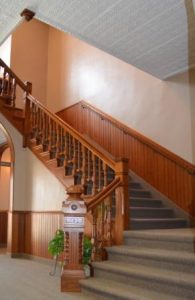
On June 1, 1888, a petition bearing 67 names was presented to the county board requesting a bond election to build a courthouse. The election was held July 10, 1888 and the bond issue for $20,000 was approved 801 to 453.
George W. Shaffer of Abilene was awarded the contract to draw up the plans for the courthouse. However, shortly thereafter, the commissioners reconsidered and hired L.L. Levering to prepare the plans. The construction contract was awarded September 3, 1888 to William T. Heaps in the amount of $17,950 and work began two days later. The project was hindered by considerable bickering between the contractor, the commissioners, and George Shaffer, who was the superintendent of construction. Allegedly the plans were poorly drawn and the commissioners insisted on making numerous changes. Despite the delays, the building was finished by the spring of 1889 except for the landscaping and the sidewalks.
The Rush County courthouse is architecturally, politically, and locationally the most important building in Rush County. Architecturally it is rivaled only by Saint Joseph’s Catholic Church in Liebenthal. Politically it represents the government of the county and locationally it is at the heart of La Crosse and Rush County. The courthouse was listed on the National Register of Historic Places in 1972.
The building is Romanesque in style. It is constructed of dark red brick laid in common bond. The structure, which is two stories high, rests on a rough-hewn native limestone base. The original building is generally rectangular with towers at the northeast and southeast corners. The southeast tower is round with a conical roof topped by an onion-shaped finial. The northeast tower is square and when built had a steeply pitched hip roof. Arched openings pierce the upper part of the square tower.
The main entrance, reached by a set of wide masonry steps, is set within a stone arch that is repeated twice above in the projecting entrance bay. These arches occur again in the square tower above the second floor window openings and above the semicircular window openings in the attic level on the north and south sides. Other windows occur in sets of three or singly with the upper portions glazed with small panes of stained glass. A metal cornice extends around the building under the roofline except where interrupted by the projecting bays and towers.
Over the years the courthouse has undergone a number of changes. In addition to the loss of the tall roof over the northeast tower from wind damage, the wooden front doors have been replaced with aluminum-framed doors. The tall, hipped roof of the building is now covered with composition shingles instead of tin. The many tall brick chimneys of the original structure are gone. A modern addition at the rear accommodates an elevator making the courthouse handicapped-accessible. This addition connects the courthouse with a brick and stone building that once was the Rush County jail and now is the office of the county sheriff.
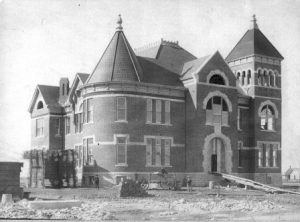
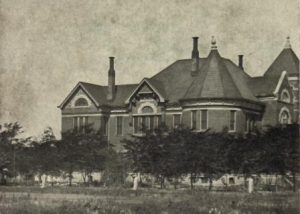
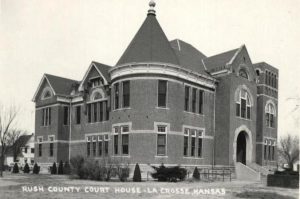
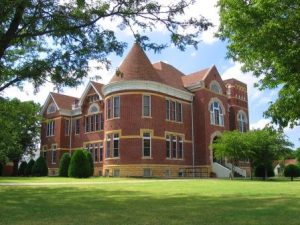
Rush County Courthouse – 2010
In the early 20th century, the building was nearly obscured by dense trees surrounding the building. A tree-lined boardwalk along the front of the building was known as Lovers Lane. By the 1950s, most of the trees had been removed.
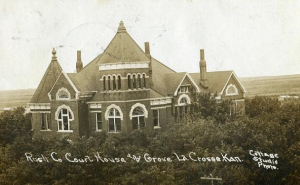
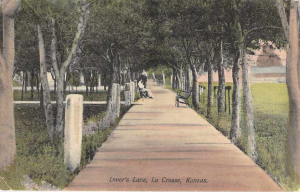
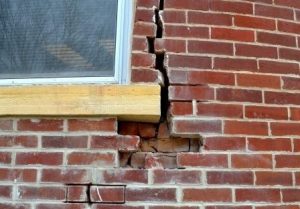
Over the years, mortar joints had begun to deteriorate and cracks formed in the 100+ year old walls.
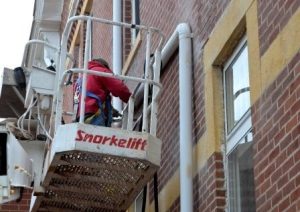
With assistance from a grant provided by the Heritage Trust Fund and the Kansas State Historical Society, crews were hired to repair the brick and front steps of the building.
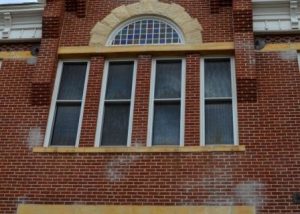
As a result of the repairs, the building will once again be structurally sound for many years to come.